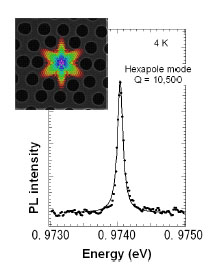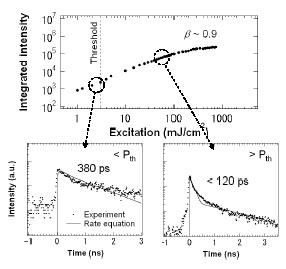Takehiko Tawara1, Hidehiko Kamada1,
Yong-Hang Zhang2,
1Optical Science Laboratory, 2Arizona State University
Photonic crystal (PhC) is advantageous for constructing nanocavities
with a high quality factor (Q) and a wavelength-sized modal volume (Vm).
A high Q/Vm nanocavity enhances the spontaneous emission rate of an active
medium inside the cavity, and this enables us to produce optical devices
with high efficiency and a low power consumption. Moreover, the use of
semiconductor quantum dots (QDs) as an active medium will lead to higher
efficiency owing to the suppression of phonon scattering and the surface
recombination of carriers. Such QD PhC nanocavities are promising for use
as ultrasmall and internal laser sources for photonic integrated circuits.
In general, QD PhC nanocavities have a III-V semiconductor heterostructure
consisting of, for example, GaAs-based materials. However, in many cases
the Q value was only several thousand, and this is insufficient to achieve
the nanocavity effect. Certain factors are assumed to cause this problem;
(i) the accuracy of the dry etching process is too low to obtain a high
Q cavity, and (ii) there is a large optical loss induced by the re-absorption
effect caused by QDs that are not coupled with the cavity mode.
To achieve high processing accuracy, we used EB lithographic resist as
an etching mask and optimized the etching conditions for each layer with
a different composition [1]. We also designed the PhC structure, including
the materials composing it and the cavity mode detuning to the QD inhomogeneous
broadening, to suppress the re-absorption effect. A Q of over 10,000 was
achieved by making these improvements (Fig. 1) [2]. Moreover, a lasing
action with very high spontaneous emission coupling to the lasing mode
(β) was observed as a result of the excitation power dependence of the
PL intensity and carrier lifetime (Fig. 2) [3].
These results provide us with a guideline for the structural design and
fabrication method, and are important in terms of achieving highly efficient
ultrasmall light sources.
[1] T. Tawara, et al., Jpn. J. Appl. Phys. Phys. 45 (2006) L917.
[2] T. Tawara, et al., IPRM2007, Matsue, Japan, May 2007.
[3] T. Tawara, et al., CLEO/QELS2007, Baltimore, USA, May 2007.
 |
 |
|||||
|
|